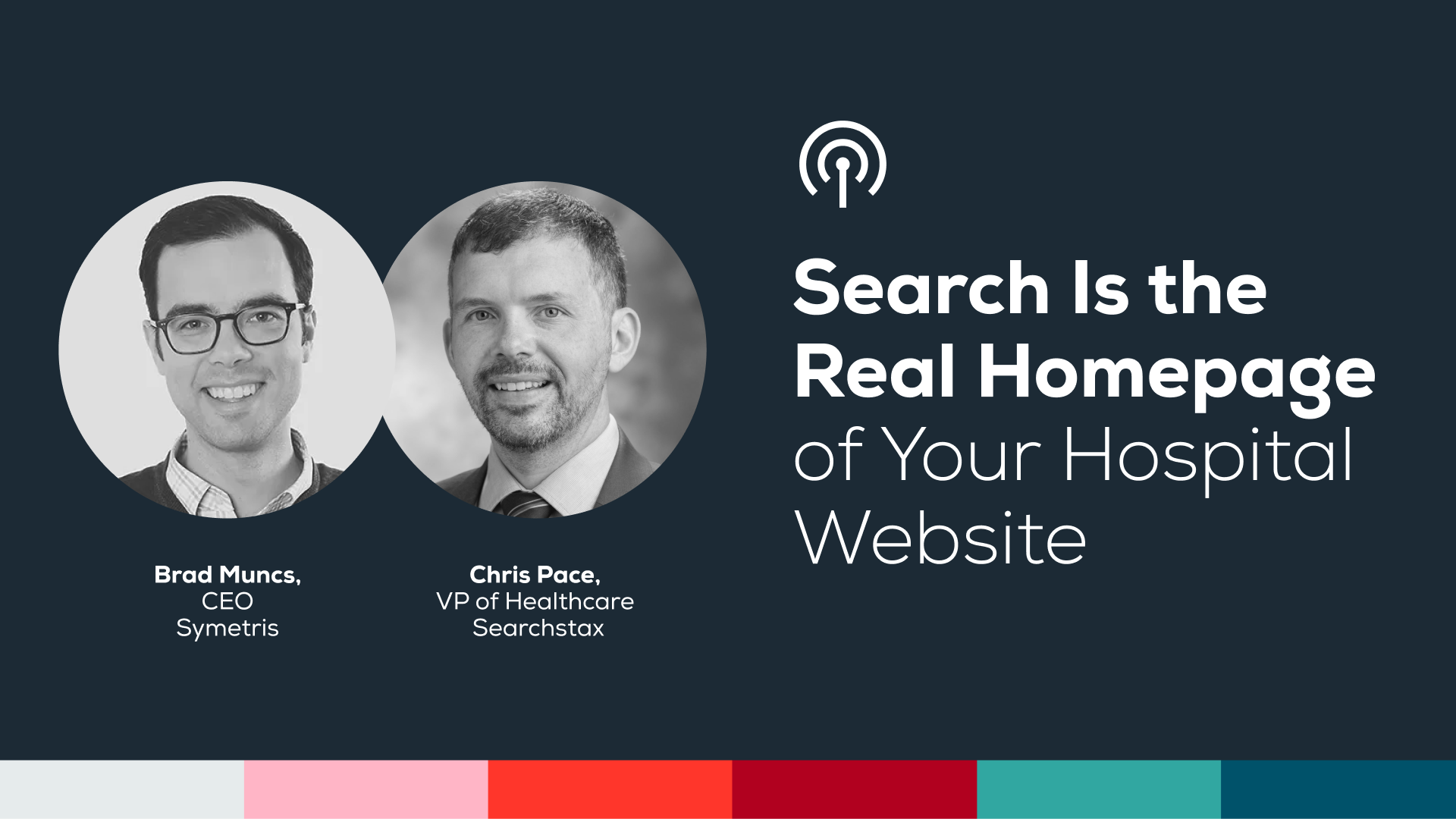Search Is the Real Homepage of Your Hospital Website
Patients aren't starting on your homepage—they're searching. Learn how hospital marketers can transform search from a pain point into a strategic asset.

A Conversation with Chris Pace, VP of Healthcare at Searchstax
[Listen to the full conversation on Youtube or Spotify]
When Chris Pace talks about hospital websites, people listen. As the former Senior Director of Digital Marketing a large, nonprofit health system and now leading healthcare at Searchstax, he’s shaped how millions of patients find care online. In a recent podcast conversation with me, Chris shared a startling reality: less than 10% of visitors even land on the homepage.
In Chris’s tenure in healthcare marketing, nearly 70% of patients went straight to search — looking for a doctor, a location, or a service. In other words, the search results page, not the homepage, is where the real patient journey begins.
“It’s almost fair to say that your search results page is your homepage.”
— Chris Pace
If search is the real homepage of your hospital website, then healthcare marketers need to rethink how they design it, measure it, and use it to build trust.
When Search Fails, Patients Leave (and Costs Rise)
Most health systems don’t treat search like the critical entry point it is. Instead, it’s fragmented across different tools: a doctor finder here, a location finder there, a separate system for classes or events. Each one runs on its own platform, with its own look and feel. Patients bounce between them, wondering if they’re even still on the same site.
“It feels as though [search] is an afterthought.”
— Chris Pace
The result is a clunky experience that doesn’t match what patients expect from search results: quick, intelligent answers that “just work.”
That mismatch isn’t just frustrating; it’s costly. Every time a visitor gives up on search and calls instead, the health system absorbs the hit. Chris noted that each call could cost $10–$20.
At his previous health system, Chris led a project to unify these fragmented tools into a single, intelligent search experience. The result was a smoother path for patients and measurable reductions in call volume: proof that fixing search pays off both for patients and the organization.
Search Results Are Your First Impression to Patients
Chris shared that nearly 70% of his previous health system’s visitors used some form of search. That number tells the story. Patients are not entering through the homepage: they are starting with the search bar. Which means the search results page is their true first impression of your hospital online.
And yet, most organizations pour resources into polishing service line pages, homepage carousels, and campaign microsites while leaving the search page untouched. It is often the least designed page on the entire site, despite being the most visited. That should make every healthcare marketer pause.
Patients notice. They expect results that are easy to scan and organized by type: a doctor profile, a location, a service. They expect filters that help them narrow down options quickly. What they usually get instead is a flat, unhelpful list of links.
The inconsistency is even worse when hospitals push patients into third-party tools with a completely different look and feel.
“Hospitals polish the homepage for executives, but patients judge the entire brand on the search results page.”
— Brad Muncs
When the experience breaks, so does trust. If healthcare is built on trust, then it is astonishing how often health systems ignore the very page that defines it.
Search Data Is Market Intelligence Hiding in Plain Sight
Every search query is a patient raising their hand and telling you what they came for. Yet most healthcare marketers never look at this data. That is a wasted opportunity.
Chris highlighted two areas that should be non-negotiable:
- Zero-result searches
These show where patients are asking for something your site does not deliver. That is a content gap you can fix immediately. - Top searches
These reveal what patients actually want most. This data shows not just marketing opportunities but even operational insights, such as demand for orthopedic care or seasonal spikes in flu shot interest.
This is more than a digital tactic. Search data is market intelligence. It can guide service line promotion, content planning, and even strategic growth decisions. And it is sitting there, free for the taking, inside your own website.
“Zero-result searches show where patients are asking for something your site does not deliver.”
— Chris Pace
Most organizations spend heavily on external market research while ignoring the simplest signal of all: what patients are typing into their search bar. If search is the real homepage, then it is also your clearest window into demand.
Treat Search Like the Page Patients Rely On
Marketers obsess over the homepage, but patients are making decisions on the search results page. It deserves at least as much attention as any service line or campaign page.
So where should you begin?
- Audit search usage. Understand how many patients use it and where they get stuck.
- Turn data into content. Use search insights (especially zero-result queries) to guide what you publish next.
- Improve usability. Adjust filters, layout, and UI to make results easier to scan. If your current tool can’t support this, then plan for a more significant redesign.
How is the search experience faring on your website today?
At Symetris, we work alongside partners like Searchstax to help healthcare marketers turn search into a true strategic asset. For a deeper dive, listen to my full conversation with Chris Pace, where we explore how better search builds trust, improves patient experience, and delivers measurable ROI.
